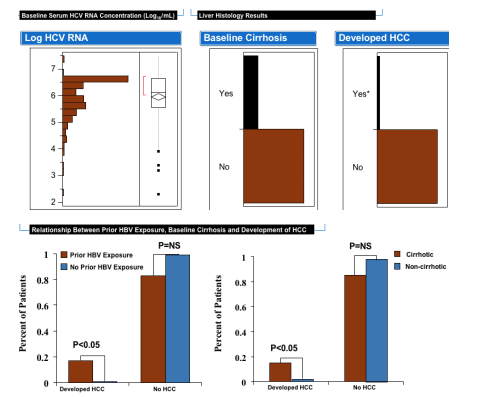 |
 |
 |
| |
Development of HCC in Patients who Achieve SVR to IFN-Based Therapies is Associated with Cirrhosis and Prior HBV Exposure
|
| |
| |
Reported by Jules Levin
AASLD, Oct 2006, Boston, MA
M. J. Tong1,2; S. Tu2; J. T. Cheng2; L. M. Blatt1,3
1University of California at Los Angeles, Los Angeles, California, 2Huntington Medical Research Institutes, Pasadena, California, 3InterMune, Brisbane, California
The long term benefit of IFN-a + ribavirin therapy in chronic Hepatitis C patients who achieve an SVR is largely unknown however; previous studies have reported evolution of hepatocellular carcinoma (HCC) in some patients.
To assess clinical benefit of SVR in our community practice, we examined 237 patients with SVR following standard IFN, standard IFN + ribavirin or Peg-IFN + ribavirin therapy. Patients were assessed for HCV RNA and development of cirrhosis and HCC during follow-up. The mean follow-up time was 46.96 ± 2.5 months. All but one patient (99.57%) remained HCV RNA negative throughout the follow-up.
At baseline 40% of patients were HCV Genotype 1, mean HCV RNA was 5.94 ± 0.8 log10 copies/mL, 46 (20%) patients had cirrhosis and 42 (37%) were HBcAg positive (all patients were HBV DNA negative). About 60% of patients had been through 1 round of therapy, aout 15% two rounds, 5% 3 rounds, and 2% 3 to 5 rounds. Most patients had used peg+RBV or pegIFN, although abour 30% had used standard IFN. During follow-up, no patient developed cirrhosis however 9 patients (4%) developed HCC. Univariate analysis of variables significantly associated with HCC revealed lower mean serum albumin and platelet counts, prior HBV exposure (anti-HBc +), presence of cirrhosis prior to therapy and HCV genotype 1 as significant (p<0.05 for all observations). Multivariate analysis revealed anti-HBc positivity and cirrhosis as independent predictors of HCC (anti-HBc +, OR 12.5 (1.9-248) cirrhosis at baseline OR 13 (2.5-99) p<0.05 for all observations).
Our study suggests that patients with cirrhosis who achieve SVR should be monitored closely for development of HCC and that determination of prior HBV exposure even in patients who are HBV DNA negative may help predict SVR patients at risk for HCC. NOTE from Jules Levin: In other words, don't delay therapy too long!
AUTHOR SUMMARY & CONCLUSION:
Chronic Hepatitis C patients who achieve SVR may still be at risk for development of HCC.
Patients with prior exposure to HBV and cirrhosis prior to obtaining an SVR are 12.5-and-13-times more likely to develop HCC compared to patients without these risk factors.
Patients with these risk factors should be monitored closely for development of HCC even if they achieve an SVR following therapy.
Further study is warranted.

|
| |
|
 |
 |
|
|